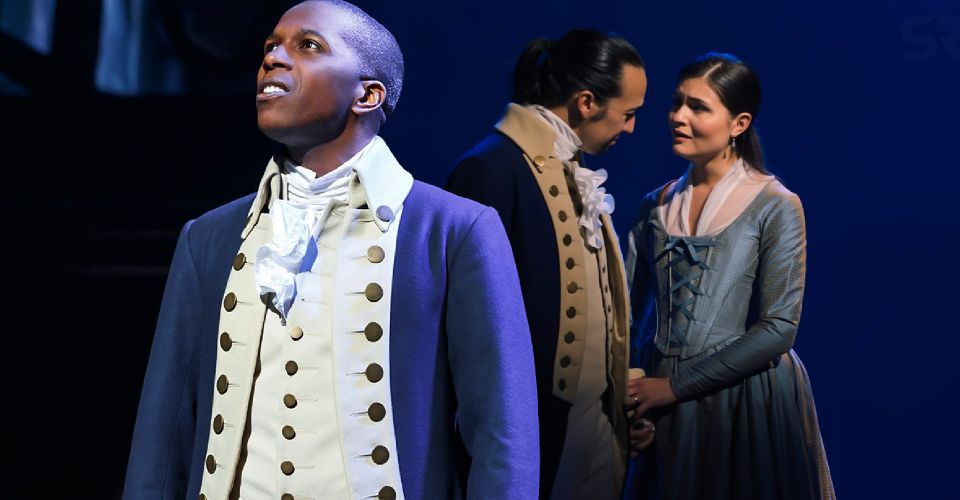Hamilton: What Happened To Every Major Character After The Musical

Lin-Manuel Miranda’s Hamilton focuses primarily on its title character – but what happened to everyone else once the curtain closed? From the enigmatic Aaron Burr to the witty Angelica Schuyler, Hamilton is filled with intriguing secondary characters. However, Hamilton does not include much about their lives outside of how they impacted Hamilton, so audiences learn little about what happens to them after his death.
Luckily, there’s enough information out there to fill in the gaps. Characters like Eliza and Hercules Mulligan lead lives Hamilton viewers might see coming, but characters like Aaron Burr detour from the life paths they seem to be taking at the end of the musical. The only consistency among the characters in Hamilton is that their lives are documented by historians.
Hamilton: Biggest Differences Between Broadway & The Disney+ Movie
After Hamilton dies in his duel with Burr, life goes on for the other characters in the show. While some characters die around the same time as Hamilton, others outlive him by decades. Here’s everything that happened to Hamilton’s major characters after the musical ended.
Eliza Hamilton

When Eliza takes over Burr’s position as narrator in “Who Lives, Who Dies, Who Tells Your Story,” she briefly sums up her life after Hamilton’s death – but the play doesn’t get into specifics. The time surrounding Hamilton’s death was undoubtedly traumatic for Eliza; both of her parents died the same year as her husband. However, Eliza didn’t let her grief hold her back for long.
In the play’s final song, Eliza sings, “I founded the first private orphanage in New York City.” This line is historically accurate, and the orphanage was called the Orphan Asylum Society. She served as directress for 27 years, and the society still exists under the name Graham Windham. It now functions as a youth development organization, and the Hamilton cast led fundraisers and helped generate huge donations to the organization. Outside of philanthropy, Eliza’s main focus was preserving Hamilton’s legacy. She consistently defended him against people who tried to tarnish his ma,e and helped get his biography published. At 97 years old, she died in 1854 – fifty years after Hamilton’s death.
Angelica Schuyler

In “The Reynolds Pamphlet,” Angelica returns to New York after Hamilton revealed his affair. This was in 1799, and she stayed in New York for the remainder of her life. She had been living in Europe for 16 years with John Barker Church – the “wealthy husband” whom she mentions in “Non-Stop.” Once returning to New York, she and Church began construction on a thirty-room mansion called Belvidere in Belmont, New York. The house still stands today.
Near her mansion in Belmont was a small village that her son founded and named after her. Angelica is still a functioning small town in rural New York. After Hamilton ended, Angelica lived out the rest of her life as a member of the social elite. She died in 1814 at 58 years old.
Peggy Schuyler

Peggy is the Schuyler sister that Hamilton spends the least time on. This might partially be because her death preceded Hamilton’s – she died in 1801, three years before Hamilton’s duel with Burr. Since Peggy died before the end of the musical, here is everything that happened to her after she made her exit in Act 1.
At 25 years old, Peggy married Stephen Rensselaer III, a man who came from one of the wealthiest families in New York. She had three children with Rensselaer, but only one child survived to adulthood. In 1799, she fell gravely ill, and Hamilton often visited her bedside. She was 43 years old when she died, leaving only Angelica to comfort Eliza in “Who Lives, Who Dies, Who Tells Your Story.”
Aaron Burr

Aaron Burr’s life was certainly the most dramatic out of any of Hamilton’s major characters. After his duel with Hamilton, his reputation was in shambles. Jefferson was planning on dropping his as Vice President after his first term in office, and he had to worry about facing murder charges for Hamilton’s death. What happened next is somewhat unclear, but many historians speculate that Burr conspired against the United States.
There’s not much that historians know for sure about this time, but they are certain that Burr tried to raise an army on America’s western frontier. He contacted a British minister suggesting to “effect a separation of the Western part of the United States.” No one is certain why Burr took these actions, but some have accused him of planning to start a new nation and declare himself emperor.
This plan didn’t last long – one of his accomplices exposed him to Thomas Jefferson, and Burr was tried for treason. While Burr was ultimately found not guilty, this verdict didn’t change public opinion. Decades after his wife’s death, Burr remarried at 77 years old but divorced soon after – a course of events that damaged his reputation even further. After having a debilitating stroke in 1834, Burr died in a boarding house in 1836. He outlived Theodosia, the daughter he sings about in “Dear Theodosia.”
Hercules Mulligan

Hercules Mulligan’s life after Hamilton was a little bit more boring than that of other major characters. During the Battle of Yorktown, Mulligan was already 41 years old and had accomplished quite a bit as a spy. However, after the war ended, Mulligan settled down with his wife and lived a peaceful life as a tailor. Mulligan and his wife had three sons and five daughters together. In 1985, Hercules Mulligan became one of the 19 founders of the New York Manumission Society, one of the first organizations in the United States dedicated to opposing slavery. He ultimately died in 1825 at 84 years old.
Lafayette

Lafayette doesn’t stick around for all of Hamilton, as he leaves after Act 1 to fight in the French Revolution. However, the French Revolution was much more complicated than the American one, and Lafayette’s stance was not quite as straightforward. While many French civilians wanted complete destruction of the royalty, Lafayette hoped and argued for a constitutional monarchy. This somewhat centrist stance left Lafayette in an awkward position during the Revolution. He wrote the Declaration of the Rights of Man and of the Citizen, but he actively repressed revolutionaries who pushed to destroy the royal system.
When the king and queen were ultimately overthrown, Lafayette had to defect to Austria to escape the Reign of Terror. As chaos continued in France, Lafayette was able to return and sat in the Chamber of Deputies for most of King Louis XVIII’s reign. He also installed Louis-Philippe as France’s “citizen king” after the July Revolution. When Lafayette died in 1834, he was buried in dirt from Bunker Hill. He left behind a legacy as the “Hero of Two Worlds” due to his work in two major revolutions.
Thomas Jefferson

After the end of Hamilton, Jefferson continued to serve as President of the United States until 1809. During his time in office, he handled the Louisiana Purchase, banned the international slave trade, and supported the Lewis and Clark Expedition. After his presidency, Jefferson founded the University of Virginia, fulfilling a dream he had before the Revolutionary War had begun.
Jefferson and John Adams were close friends during the Revolution, but quickly became rivals after the war ended. This rivalry followed Jefferson to his death at 83 years old. Coincidentally, Jefferson died on July 4th, 1826 – the 50th anniversary of Independence Day. Adams died a few hours later, but he didn’t know yet that Jefferson had passed. His final words referenced the rivalry: “Thomas Jefferson survives.” Jefferson and Adams were the last two founding fathers to die.
James Madison

At the time of Hamilton’s death, Madison was serving as Secretary of State, and in 1809, he succeeded Jefferson as President. Madison’s presidency was extremely eventful. After British sailors interfered significantly with American shipping, Madison tried to solve the issue diplomatically, but ultimately began the War of 1812. The war was widely perceived as a “second war of independence,” and many Americans were happy with the results.
After the war, Madison created the Second Bank of the United States. He also added 23 million acres to the United States after taking that land from Native Americans. After his presidency, Madison retired and died in 1836 of congestive heart failure. One unconfirmed account of his death claims that Madison was eating breakfast and could not swallow. When his niece asked him what was wrong, he said “Nothing more than a change of mind, my dear,” and immediately died. He was 85 years old.
Maria Reynolds

Maria Reynolds only has one song in Hamilton, and audiences don’t learn all that much about her character. In Hamilton, she was somewhat of a plot device, but Maria Reynolds was a real person with an interesting life. She was 23 years old when she began her affair with Hamilton, and by the time the Reynolds Pamphlet was released, she and Reynolds had been divorced for many years. Maria’s life was not recorded very thoroughly. After divorcing Reynolds, she remarried and moved to England. She ended up marrying for a third time and living out her life in Philadelphia. She had one daughter named Susan, and died at 59 years old in 1828.
King George

King George is Hamilton‘s comic relief. He is ridiculous and ostentatious, as Hamilton plays into his reputation for being “mad.” This isn’t completely accurate – King George was mentally ill, but he wasn’t the evil maniac that Hamilton portrays. Although the diagnosis did not exist at the time, many historians believe that King George had bipolar disorder. He suffered from on-and-off bouts of “mania,” and his mental health began to significantly deteriorate in 1810. At this point, his son George ruled as Prince Regent. King George lived in isolation until his death in 1820 at 81 years old. Despite his reputation of being “mad,” he is generally remembered as a good ruler.
Certain Hamilton characters led more interesting – or at least more well-documented – lives than others. Eliza’s life after Hamilton was likely fulfilling for her, but it doesn’t exactly take any exciting twists and turns. Meanwhile, Aaron Burr and Lafayette lived lives so eventful that they warrant their own musicals. While each of these characters met briefly, their lives clearly diverged after Hamilton’s death. Although their lives were not as heavily featured onstage as Hamilton’s, that doesn’t mean that they were unimportant or unimpactful. Ultimately, each of these characters played important roles, both to Hamiltonand to history. The line “history has its eyes on you,” applies to everyone onstage.
Hamilton Ending: Alexander’s Death & The Final Song Explained
About The Author

















